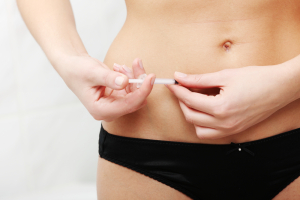Introduction
Human growth hormone use has become popular recently through the Olympics and other competitive sports.
It has been used by some athletes illegally to build up muscle mass, which is one of the effects of human growth hormone. The reason it is stressed that it is “human” is due to the fact that for a long time it could not be synthesized and it was extracted from the pituitary glands of pigs or cattle.
However, there were immune reactions to these preparations as the human body reacted to the other species’ protein components. Later it became popular (in the 1970’s and 1980’s) to extract human growth hormone from pituitary glands of human corpses. However, cases of AIDS and Creutzfeld Jacob disease (= human BSE) were reported that transmitted directly from diseased people to children with dwarfism that were treated with human growth hormone.
Fortunately, modern technology came to help in this precarious situation, before it was too late: recombinant technology where bacteria are programmed to synthesize pure human growth hormone is now the procedure of choice. It is readily available from special pharmaceutical labs, is 100% pure, is affordable and is always the same dosage from batch to batch. It aslso is 100% free from bacteria, viruses or mad cow disease pathogens (prions).
For brevity I will refer to it here as “growth hormone”( or GH), but it is understood that it is “human”, either the natural hormone in the body or the 100% pure recombinant human growth hormone used for treatment nowadays.
How does growth hormone (= GH) work?
The hypothalamus in the center of the brain monitors and regulates all the major hormone systems including growth hormone. It does so by two mechanisms: the one is the secretion of growth hormone releasing hormone (= GHRH), which specifically releases GH from the pituitary gland. The second mechanism is the secretion of another hormone called somatostatin, which counteracts the effect of GHRH. GHRH stimulates cyclic AMP formation in the pituitary gland, but somatostatin inhibits its formation (Ref.1, p.231). Apart from somatostatin, elevated insulin levels can also inhibit cyclic AMP formation interfering with GH release from the pituitary gland. GH acts on fat cells and on liver cells. The fat cells release the energy required to build up muscle mass. The liver cells release a set of hormones called insulin-like growth factors (IGF), the most important of which is IGF-1. As IGF-1 is very similar to insulin in structure, there is competition with regard to its receptors on the muscle tissue. Also, with elevated insulin levels such as in diabetes mellitus, type 2, or with the metabolic syndrome, there is a reduction of the IGF-1 binding protein, which in turn leads to a net loss of available IGF-1 for muscle development. This leads to stunted growth (details see Ref. 1, p.232-233).
As I explained above there a complex interaction of hormones is needed to have normal growth. There are many steps where things can go wrong. Generally speaking, it is not too well known how important nutritional factors are in influencing growth, although a large body of literature exists regarding the syndrome of insulin resistance, which interferes with normal IGF-1 function. Anti aging supplements are often taken containing arginine, ornithine and lysine, which are supposedly building up HGH, but this has not been conclusively proven in human studies.
In simple words: a diet too rich in refined sugar and starch (sweets, noodles, rice, potatoes) will cut down the production of GH and IGF-1 to the point where growth can severely lack behind the norm. Growth may never catch up unless an endocrinologist treats this young patient with human growth hormone before the growth plates of the long bones have closed, which would stop any bone growth.
In adults GH is still essential for energy, for maintaining a normal muscle mass and as a natural anti-aging hormone. The way the body maintains its production seems to be through regular exercise where little bits of GH are produced. There is a daily cycle where during our sleep GH production is regenerated. One of the effects of sleep deprivation is that you will be robbed of GH production. In older persons (above age 50 to 60) HGH production has often declined to the point where there is a low blood IGF level. These patients are secondarily deficient for HGH. They will benefit from HGH injection in small daily doses until the IGF level is restored.
There are two major conditions that occur clinically: either there is a lack of GH in childhood, called dwarfism, or there is a surplus, usually because of GH overproduction in the pituitary gland from a benign adenoma that produces pathological amounts of GH (acromegaly or gigantism).
References
1. B. Sears: “The age-free zone”. Regan Books, Harper Collins, 2000.
2. R.A. Vogel: Clin Cardiol 20(1997): 426-432.
3. The Merck Manual, 7th edition, by M. H. Beers et al., Whitehouse Station, N.J., 1999. Chapter 8: Thyroid disorders.
4. The Merck Manual, 7th edition, by M. H. Beers et al., Whitehouse Station, N.J., 1999. Chapter 7:Pituitary disorders.
5. J Levron et al.: Fertil Steril 2000 Nov;74(5):925-929.
6. AJ Patwardhan et. al.: Neurology 2000 Jun 27;54(12):2218-2223.
7. ME Flett et al.: Br J Surg 1999 Oct;86(10):1280-1283.
8. The Merck Manual, 7th edition, by M. H. Beers et al., Whitehouse Station, N.J., 1999. Chapter 261: Congenital anomalies.
9. AC Hackney : Curr Pharm Des 2001 Mar;7(4):261-273.
10. JA Tash et al. : Urology 2000 Oct 1;56(4):669.
11. D Prandstraller et al.: Pediatr Cardiol 1999 Mar-Apr;20(2):108-112.
12. B. Sears: “Zone perfect meals in minutes”. Regan Books, Harper Collins, 1997.
13. J Bain: Can Fam Physician 2001 Jan;47:91-97.
14. Ferri: Ferri’s Clinical Advisor: Instant Diagnosis and Treatment, 2004 ed., Copyright © 2004 Mosby, Inc.
15. Rakel: Conn’s Current Therapy 2004, 56th ed., Copyright © 2004 Elsevier







